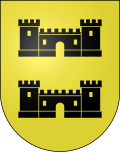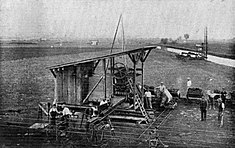Bavois
| Bavois | |
|---|---|
| State : |
|
| Canton : |
|
| District : | Jura north vaudois |
| BFS no. : | 5746 |
| Postal code : | 1372 |
| Coordinates : | 533208 / 170 824 |
| Height : | 447 m above sea level M. |
| Height range : | 437–603 m above sea level M. |
| Area : | 9.35 km² |
| Residents: | 941 (December 31, 2018) |
| Population density : | 101 inhabitants per km² |
| Website: | www.bavois.ch |
|
Bavois |
|
| Location of the municipality | |
Bavois is a municipality in the Jura-Nord vaudois district in the canton of Vaud in Switzerland .
geography
Bavois is 447 m above sea level. M. , 5 km south-southeast of the town of Orbe and 12 km southwest of the district capital Yverdon-les-Bains (linear distance). The village extends on the south-eastern edge of the Orbe plain , in the Vaud Central Plateau .
The 9.3 km² municipal area covers a section of the Vaud Central Plateau. The western part of the municipality is taken up by the agriculturally intensively used southern Orbe plain. A remnant of the once large swamp area is the Marais des Puits , the old peat pits, in which peat was extracted with Decauville peat tracks around 1920 , are under nature protection. The Entreroches Canal forms the western border . To the east, the municipality extends over the slope of Bavois to the northern foothills of the Gros de Vaud plateau and into the valley of the river Talent, which is cut deep into the molasse layers . The highest point of Bavois is 603 m above sea level. M. at the height of Maladaire south of the hamlet of Le Coudray. In the extreme south the area extends to the Cristallin brook and the Tioleire forest , which belongs to the eastern part of the Mormont . In 1997, 8% of the municipal area was in settlements, 16% in forests and woodlands, 75% in agriculture and a little less than 1% was unproductive land.
The hamlets of Les Bordes ( 513 m above sea level ) on the castle hill above the village and Le Coudray ( 593 m above sea level ) on the plateau of the Gros de Vaud as well as some individual farms belong to Bavois . The neighboring municipalities of Bavois are Arnex-sur-Orbe , Chavornay , Penthéréaz , Goumoëns , Oulens-sous-Echallens , Eclépens , Orny and Pompaples .
population
With 941 inhabitants (as of December 31, 2018), Bavois is one of the smaller municipalities in the canton of Vaud. 93.0% of the residents are French-speaking, 4.3% German-speaking and 1.4% Portuguese-speaking (as of 2000). The population of Bavois was 492 in 1850 and 566 in 1900. After the population had decreased to 407 inhabitants by 1970, a slow increase in population was registered since 1990 (496 inhabitants).
economy
Bavois was a predominantly agricultural village until the second half of the 20th century . Even today, the have farming and fruit growing an important role in the employment structure of the population. Further jobs are available in local small businesses and especially in the service sector. There are companies in the horticultural and construction sectors. The most important employer, however, is the Bavois rest stop on the A1 motorway in the municipal area . In the last few decades the village has developed into a residential community. Many workers are therefore commuters who work in the Yverdon-les-Bains area and in the greater Lausanne area .
Peat cut
During and after the First World War, the SA de Laminoirs et Cablerie Cossonay used two extensive Decauville peat tracks with gauges of 500 and 600 mm in the Marais des Puits near Bavois in the Orbe plain in the Swiss canton of Vaud.
traffic
The community has good transport connections. It is located on the main road from Lausanne to Orbe . The Chavornay motorway junction on the A1 (Lausanne-Yverdon) opened in 1981 is around 3 km from the town center. On May 7, 1855, the Yverdon - Bussigny-près-Lausanne section of the Neuchâtel - Lausanne railway line was inaugurated with a station in Bavois.
history
Bavois can look back on a very long tradition of settlement. The earliest finds of settlement traces date to the time around 2400 BC ( bell beaker culture ). Other finds are known from the Bronze and Roman Ages. Some graves date from the early Middle Ages .
The first written mention of the place took place in 1182 under the name Baioes . Later the names Baoies (1200), Baioies (1213), Bavoes (1225), Bayoies (1270), Bayoyes (1275), Bayoes (1359) and Bavoy (1536) appeared.
Bavois was the seat of the lords of Joux from France since the 12th century . In 1263 they received Bavois back from the Savoy as a feudal lordship. In the period from 1317 to 1358, the village was under the direct rule of Savoy . In the late 14th century, the market town of Bavois was founded as a counterweight to the town of Orbe. The place could never develop properly and was already in decline shortly after 1400.
With the conquest of Vaud by Bern in 1536, Bavois came to the Landvogtei Yverdon. After the collapse of the Ancien Régime , the village belonged to the canton of Léman from 1798 to 1803 during the Helvetic Republic, which then became part of the canton of Vaud when the mediation constitution came into force . It was assigned to the Orbe district in 1798.
Attractions
The reformed parish church of Saint-Léger has components from the Romanesque and Gothic epochs. As a special feature, the church has a central bell tower. Inside, wall paintings from the 14th century have been preserved, and a side chapel dates from the 15th century.
Of the two castles in Bavois that were once two, only the Château-dessus now stands on a promontory above the village; the Château-dessous in the village was destroyed during the uprising of the Bourla-Papeys (1802). The Château-dessus originates from the Middle Ages and has a round tower. Because the lord of the castle was a citizen of Bern, the castle was not affected during the Burgundian Wars . After the looting by the Bourla-Papeys, the building underwent extensive restoration in the course of the 19th century. Today it is privately owned. In the center of Bavois there are some characteristic farmhouses from the 17th to 19th centuries.
Web links
- Official website of the municipality of Bavois
- Community information
- Sabine Carruzzo-Frey: Bavois. In: Historical Lexicon of Switzerland .
- Aerial photography
Individual evidence
- ↑ Permanent and non-permanent resident population by year, canton, district, municipality, population type and gender (permanent resident population). In: bfs. admin.ch . Federal Statistical Office (FSO), August 31, 2019, accessed on December 22, 2019 .






